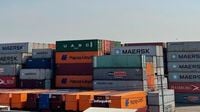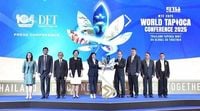Thailand's tapioca industry is at a pivotal moment as it faces new challenges and fresh opportunities on the global stage. The Department of Foreign Trade, under the Ministry of Commerce, is gearing up to host the highly anticipated World Tapioca Conference 2025 (WTC 2025) from July 29 to 30, 2025. This event, themed "Thailand Tapioca Next: GO Global Go Together," aims to unite stakeholders across the supply chain and showcase Thailand's commitment to strengthening its position as a leading tapioca exporter.
The backdrop to this conference is a shifting international trade environment. The United States has announced plans to impose import tariffs on competing countries, including a 20% tariff on normal goods from Vietnam and a hefty 40% on goods transshipped through Vietnam. Indonesia faces a 19% tariff. Meanwhile, Thailand's tariff rates with the US remain under negotiation, with no final agreement reached yet, leaving exporters and policymakers in a state of cautious anticipation.
According to Ms. Arada Fuangthong, Director-General of the Department of Foreign Trade, these developments could have significant implications. "The final tariff rate for Thailand will determine how competitive we are against rivals like Vietnam and Indonesia," she explained. "But it's not just about the tariff percentage; we must also consider the nature of Vietnam's exports to the US—whether they are direct exports or transshipments subject to higher tariffs." This nuanced understanding is crucial because if most Vietnamese exports are transshipped goods, they would face the higher 40% tariff, potentially offering Thailand a competitive edge if its tariffs remain lower.
Thailand currently exports approximately 100,000 tons of raw tapioca flour and sweeteners annually to the US, valued at around $60 million. Historically, these exports have enjoyed tariff-free access. However, if the US imposes a 36% tariff on Thai tapioca products, as speculated, it would undoubtedly hamper Thailand's export capabilities in this key market. Mr. Amnat Sukprasongpol, President of the Thai Tapioca Trade Association, emphasized the stakes: "If Thailand faces higher tariffs than Vietnam, our ability to compete in the US market will be severely impacted." He urged both the government and private sector to accelerate efforts to diversify export markets, highlighting Malaysia, the Middle East, and, importantly, China—the largest buyer of Thai tapioca, accounting for 50-60% of total exports.
In response to these challenges, the Department of Foreign Trade is not standing still. The upcoming WTC 2025 is designed to be more than just a conference; it's a strategic platform to exchange knowledge, share innovations, and forge new trade partnerships. Over 1,000 participants are expected, including foreign government representatives, importers, exporters, media, and tapioca farmers, reflecting the industry's breadth and importance to Thailand's economy.
The conference will feature a seminar titled "From Cassava to the Future: The Path of the Tapioca Industry Towards Sustainability," focusing on the full supply chain from upstream cultivation to downstream processing. Another highlight is the seminar "Cassava...Not Ordinary: Navigating New Global Trade, Opportunities, and Challenges," which will explore emerging trends and market dynamics. Business matching sessions will facilitate direct negotiations between Thai exporters and international buyers, aiming to secure purchase orders estimated at no less than 300 million baht.
Ms. Arada emphasized the government's policy framework guiding these efforts: "Our work aligns with the government's 'Market-led, Innovation-driven, Income-generating' policy and the Ministry of Commerce's 'Increase Trade Opportunities, Open World Markets, Create Thai Opportunities' strategy." The department is committed to supporting all segments of the tapioca supply chain under the mantra "Thai Made, Thai Used, Thai Helped," aiming not only to maintain Thailand's market share but to elevate the industry's competitiveness sustainably.
Thailand's tapioca export figures illustrate both promise and challenge. In 2024, the country exported 6.47 million tons of tapioca products, generating more than 110 billion baht in revenue. The first five months of 2025 saw exports surge by 37.16% to 4.06 million tons compared to 2.96 million tons in the same period the previous year. Yet, paradoxically, the export value dropped by 12.52% to approximately 45.36 billion baht, down from 51.85 billion baht, primarily due to a decline in global tapioca prices since early 2025.
To counteract these price pressures and external trade barriers, the industry is focusing on increasing productivity. Currently, tapioca yields average 2-3 tons per rai (a Thai unit of area), but plans are underway to boost this to 5-6 tons per rai. Higher yields will reduce production costs and enhance competitive positioning globally.
Moreover, the conference will spotlight innovations in tapioca products, including tapioca noodles, pellets, and processed flour, alongside novel tapioca-derived products. These advancements are seen as vital to adding value and differentiating Thai tapioca in the crowded global marketplace.
Mr. Amnat also highlighted the importance of market diversification: "We must open new markets and reduce overreliance on any single country, especially given the uncertainties in the US market." The government and private sector's collaborative approach aims to sustain the livelihoods of tapioca farmers and strengthen Thailand's rural economy, which depends heavily on this crop.
As the WTC 2025 approaches, expectations are high. The event is poised to reinforce Thailand's leadership in the tapioca industry, foster global partnerships, and chart a sustainable path forward despite the looming trade challenges. With a clear strategy, robust government support, and industry innovation, Thailand hopes to not only weather the current storms but emerge stronger in the global tapioca arena.





